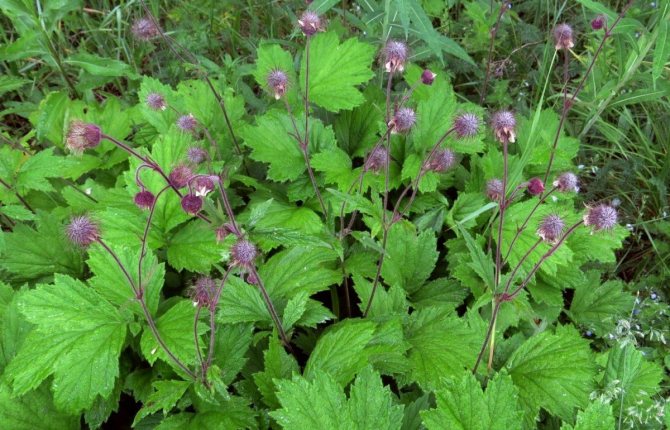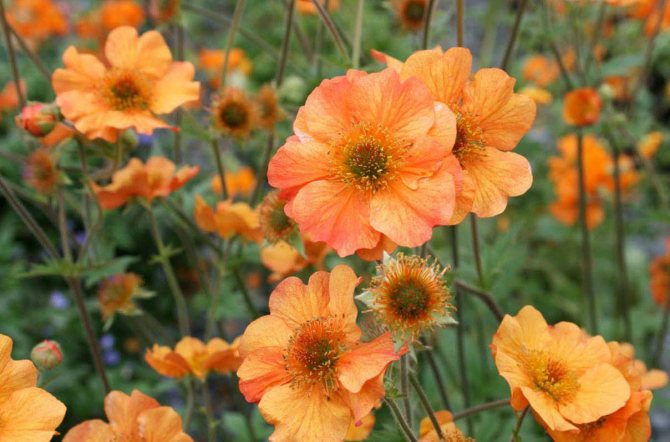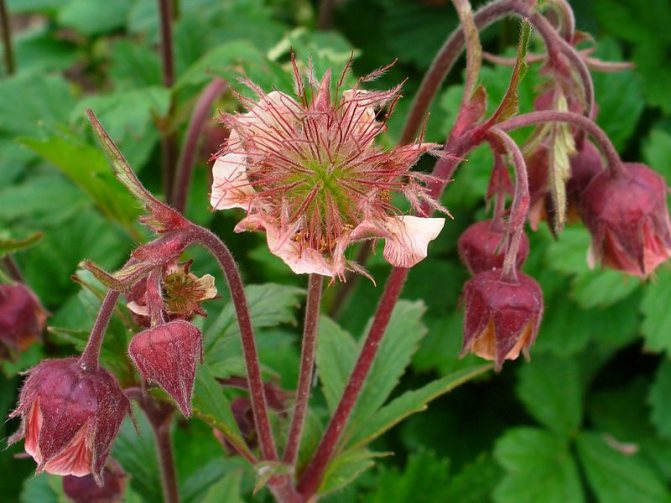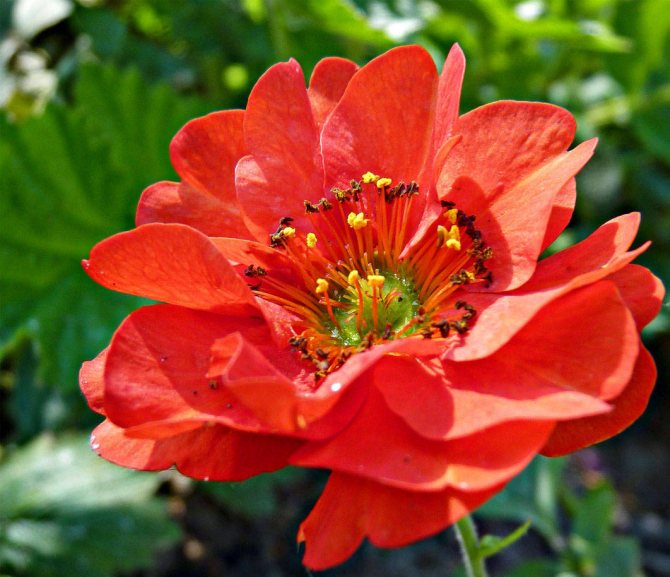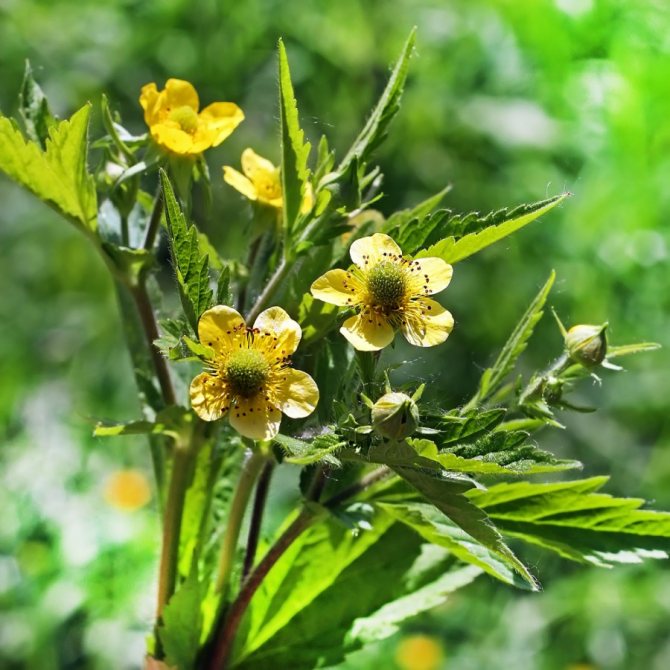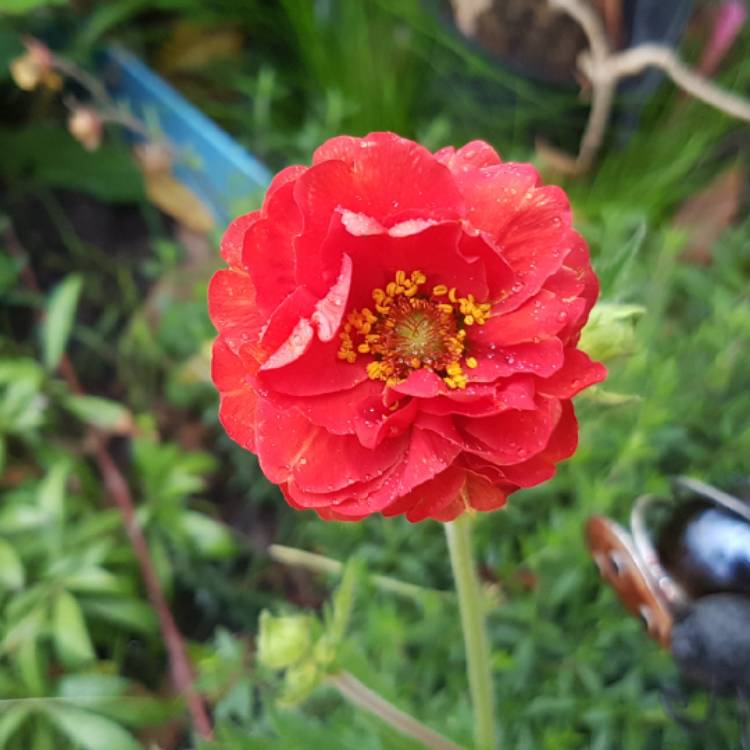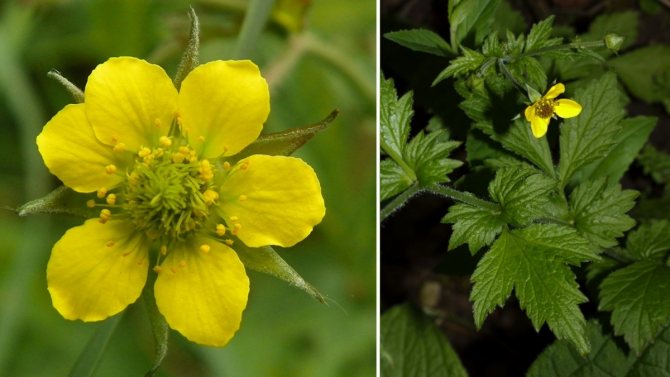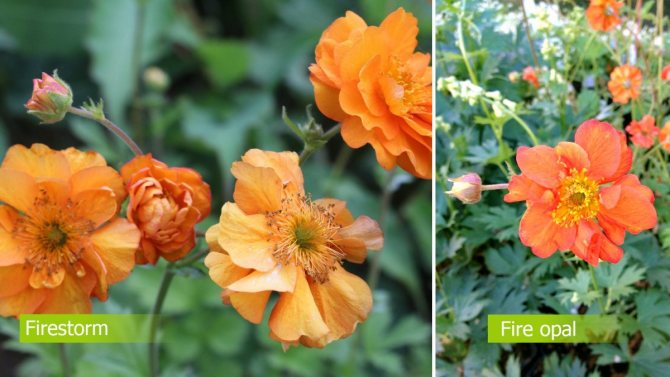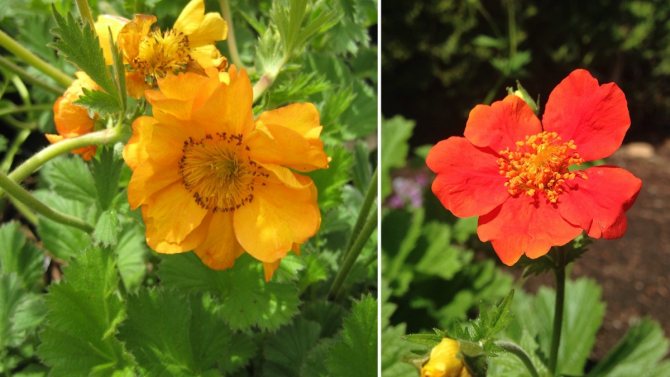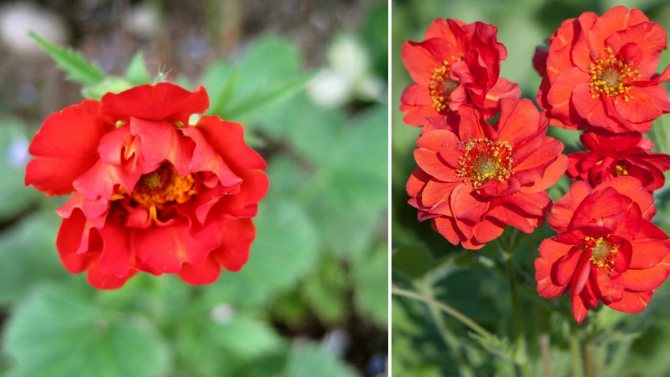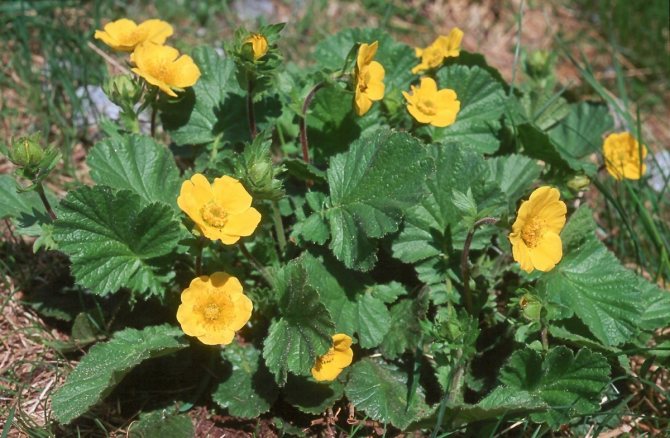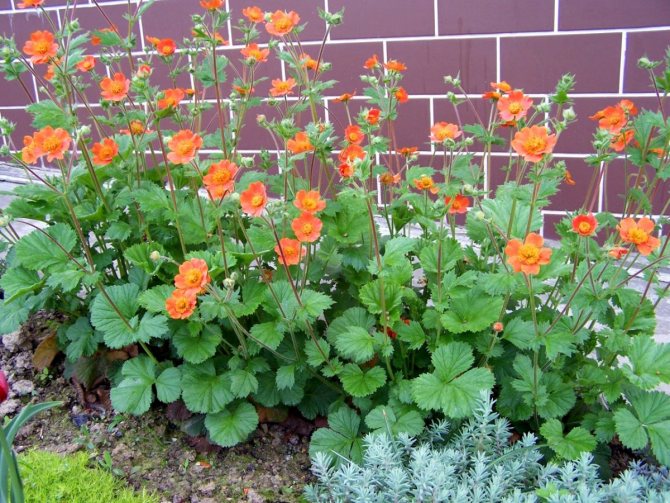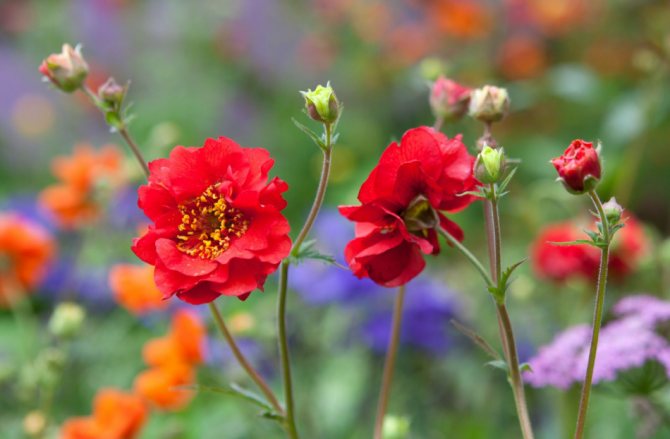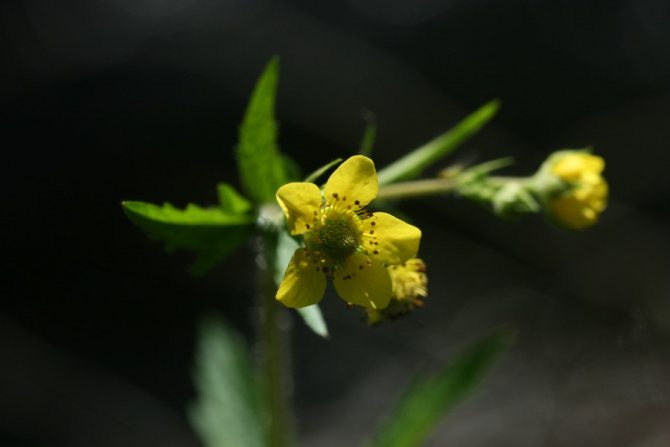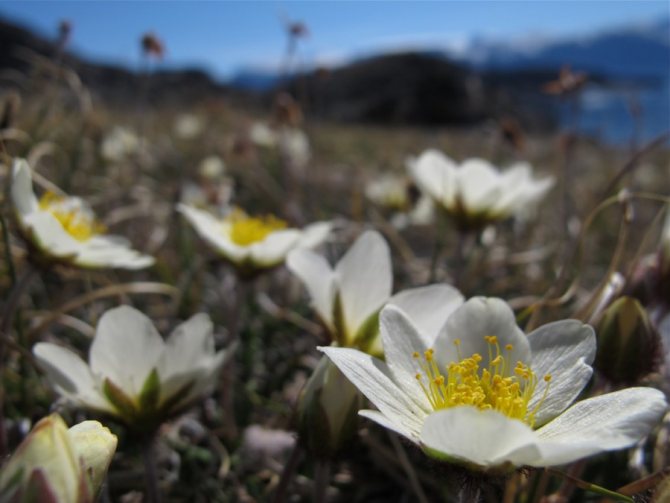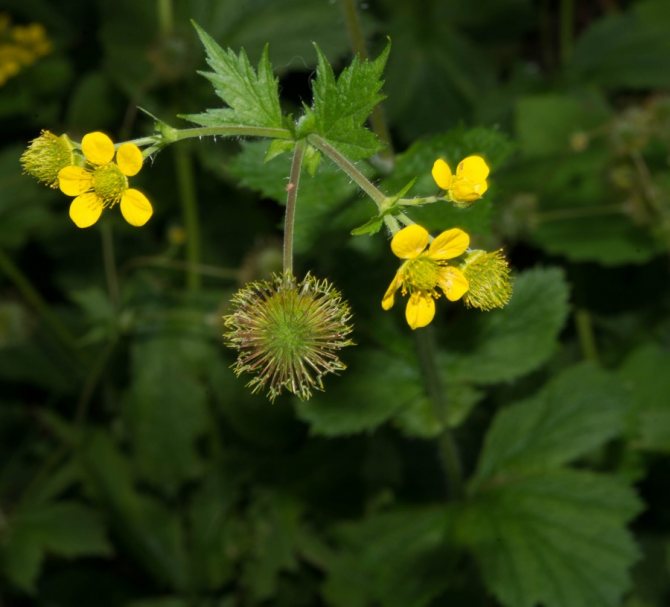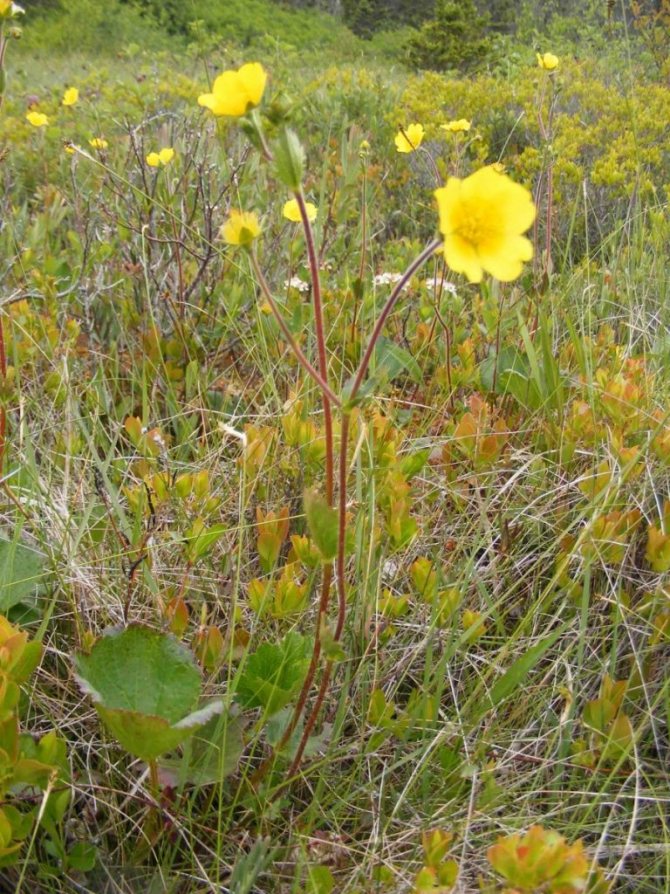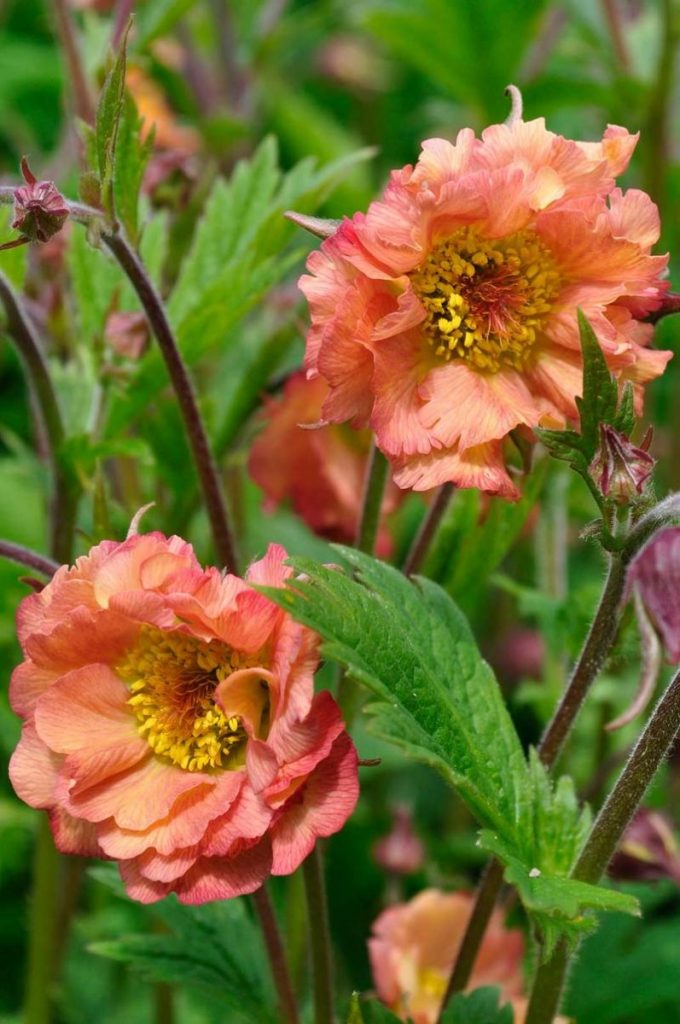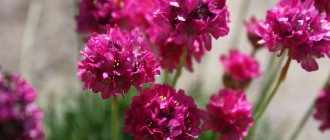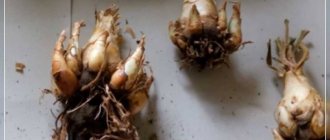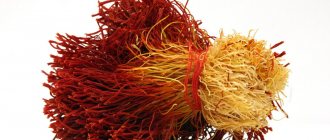Chilean gravilat flower
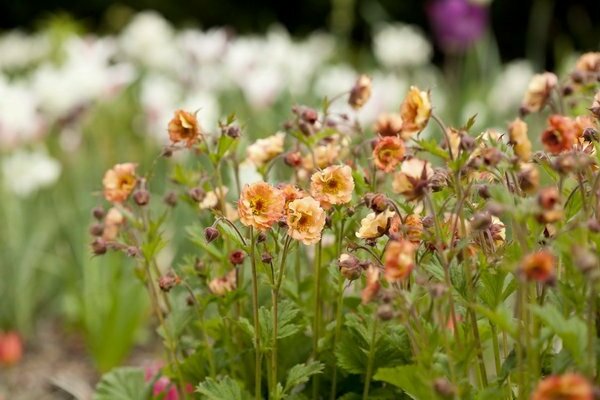
Gravilat belongs to the Pink family. It is a small perennial shrub with non-curving stems. Gravilat has a basal rosette with large pinnately dissected leaves. There are paniculate and corymbose inflorescences. The flowers are like bells; yellow, white and pink and pollinated by insects.
Also gravilat, in addition to decorative properties, is good for health.
The area for transplanting should be chosen very carefully, in order to avoid the death of the flower!
The root of the gravilat is creeping, blackish, slightly woody, located at great depths. The height of the bush is usually sixty centimeters. The flower blooms in July-August.
Brief description, main varieties
Chilean gravilat is a perennial plant species from the Rose family. Presented by beautiful herbaceous plants. According to the editorial description, the plant is native to Chile, cultivated throughout the cultural environment in many countries. On average, it reaches an average of 60 cm in height, which makes it one of the tallest representatives of the Gravilat genus. The foliage is pinnate, located in the root rosette. The flowers are red or yellow in color, reaching up to 3 cm in diameter. They are arranged in large paniculate inflorescences. Most varieties begin to bloom in the last decade of June and continue to bloom for a month and a half. There are varieties that can bloom from May to early autumn.
Note! The culture is unpretentious, it gets along well with most other plants. The gravilat flower is able to grow normally in the same place for up to 5 years without transplanting. The plant is pollinated by honey insects.
The plant is widely used in breeding for targeted crosses. This has resulted in the development of several varieties, the most famous of which are the following:
- Aurelia. The variety has yellow double flowers up to 5 cm in diameter. The bush grows to a height of 50-60 cm. Flowering begins in May and lasts until the twenties of June. In addition to decorativeness, it is valued in folk medicine. Unprotected, requires additional powder or shelter for the winter.
- Mrs Bradshaw. Plants have poly-double flowers of scarlet color, the diameter of which is 4 cm. The height of the bushes reaches 50-60 cm. Flowering lasts from June to mid-July - early August. In winter, the plantings are sprinkled with foliage.
- Red Dragon (Fireball). The plants have bright red double flowers, the diameter of which reaches 4 cm. Inflorescences are a panicle, typical of the culture as a whole. Blooms in May-July. One of the most resistant to unfavorable factors of the winter period varieties of Chilean gravilata.
- Lady Strafden Gravilath. It is characterized by deep yellow double flowers reaching up to 3-4 cm in diameter. Flowering begins in the last decade of June and lasts until the tenths of August. The variety is relatively winter hardy, therefore it can withstand winter without additional shelter.
- Moon Valley. This variety has golden yellow semi-double or double flowers 3-4 cm in diameter. Plants grow up to 60 cm in height. Flowering of this perennial begins in May and lasts until July.The variety is winter-hardy, but in the northern regions with harsh winters, it is better to shelter it.
- Rigoletto. Gravilat has double inflorescences up to 4 cm in diameter. The variety has straight stems, and the foliage is arranged in a bunch. Peduncles are beautiful, bright. Growing Rigoletto gravilata from seeds is considered the main method of its reproduction.


Chilean gravilat
Correct transplant of Chilean gravilat
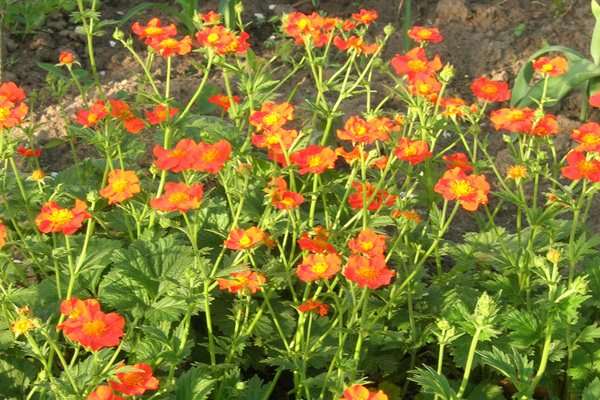

When planting, the spring should be avoided. The flower is unpretentious, but it is recommended to loosen the ground before replanting. It is necessary to fertilize the soil with humus or peat. If you plan to transplant a flower into acidic soil, it is important to add dolomite flour to it. The recommended distance between the bushes is at least twenty centimeters.
Application in traditional medicine
Infusions and decoctions from Gravilata are mainly used to stop bleeding, treat diseases of the gastrointestinal tract and the female reproductive system.
In general, plant remedies have shown themselves well in the treatment of inflammatory diseases - inflammation of the oral cavity (stomatitis), gums (gingivitis), kidneys (nephritis), prostate (prostatitis) and in getting rid of parasite infestation (for example, helminths).
In cooking
Since the roots of the plant contain a large amount of starch, carbohydrates, vitamins, and also have a spicy smell and taste, they are used for eating.
Rhizomes are ground into powder and used as spices for meat and fish, or added to alcoholic tinctures for flavor. Gravilata leaves are cooked in soups or purees.
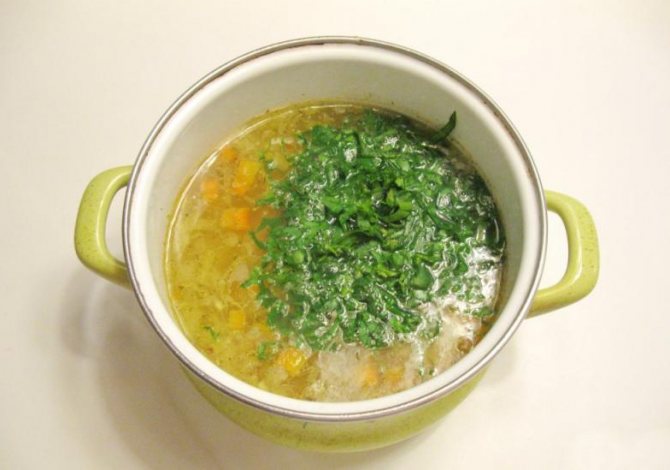

Helpful hints when planting:
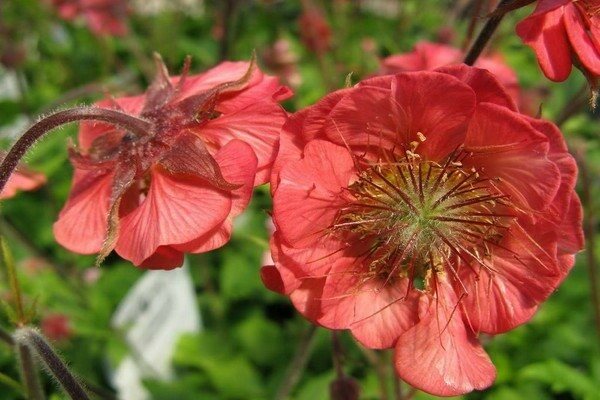

It is recommended to use low elongated ridges. They will look good as footpaths. Mixborders are also a smart solution. They are needed for a collection of constantly flowering plants.
A beautiful composition will turn out when planting a gravilat with different colors.
Alternatively, gravilat can be used as a decoration for a carpet lawn. The bush will not bloom so often, due to the lack of sufficient lighting, but it will delight the eye with beautiful greenery.
Diseases and pests
Gravilat Chilean can become infected with a fungal disease if the soil has not been disinfected before planting. Fungicides are used to fight the fungus.
During the life cycle, the plant rarely gets sick, but in the case of constant abundant watering, root rot may appear. In this case, the plant will have to be destroyed.
Spider mites can start from pests due to insufficient watering. To destroy it, you will need a drug against ticks and the restoration of a regular watering regime.
Soil care
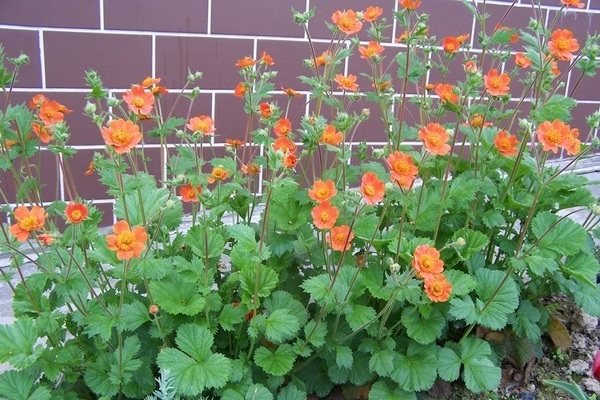

It is periodically necessary to loosen the bed in which the flower is located, and wood ash should also be added to the bud once a season. When waterlogging the soil, it is recommended to either transplant the flower, or sprinkle some soil under it.
Important! Germination of seeds can occur after a sufficient time (one to two years), this does not mean the death of the plant. If the plant is needed already this season, it is better to plant seedlings.
It may be necessary to trim. This operation is needed to remove faded inflorescences, give the bush a certain shape or rejuvenate it. The procedure will promote the germination of new shoots and will have a positive effect on the flowering of the plant.
Reproduction of gravilat
Gravilat is propagated by seeds or by dividing the bush.
By dividing the bush


It is better to propagate gravilat by dividing the bush in the spring, but it is also possible in the fall. Repeat the manipulation to improve the flower garden every 4 years.
The procedure is simple: carefully divide the roots of the mother plant so that each division has its own small rhizome and rosette. They are planted in prepared soil on a flower bed.
Dividing the bush


This process is best done in the spring, it is not recommended to repeat it more than four times a year.Daughter rosettes with pieces of the root system should be carefully separated from the mother plant. Saplings must be planted immediately and watered generously. Plant protection in winter
Chilean gravilat has good frost resistance, but it is better to protect it by covering it from frost. For shelter, you can use spruce branches or a thick carpet of fallen leaves. Cloth shelters are useless.
Interesting! A decoction of gravilat allows you to normalize sweating.
Chilean gravilat is a very beautiful plant, it can decorate any summer cottage. With proper care, the plant will delight you for a long time.
Varieties
In nature, there are about 50 species of perennial gravilata, which grow in the coastal zone of lakes and rivers in forests and meadows.
At the moment, there are about 20 cultivated varieties of flowering perennial, the main differences of which from their wild counterpart are in the length of the stem, the doubleness of the inflorescences and the general parameters of the plant.
The most popular among florists are the following varieties and varieties of gravilata:
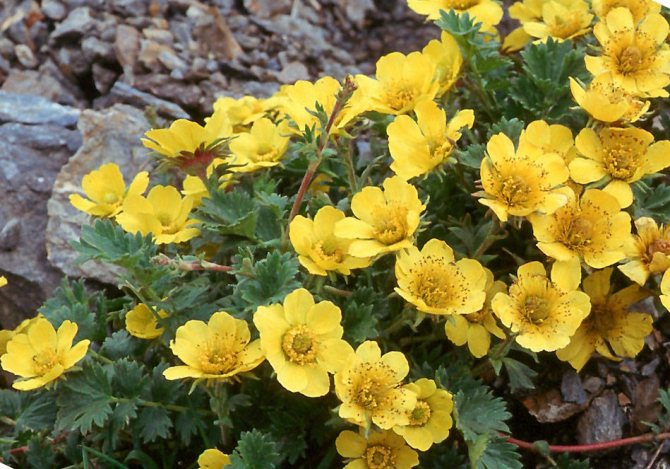

Mountain - the difference of the variety lies in the color of the inflorescences, which are pale yellow, and a relatively low height - together with the flower heads, the plant does not exceed 15-20 cm. Care in the open field for this variety is extremely simple. This variety is the best option for an alpine slide. The beginning of the flowering period is the end of spring, the duration is up to 2 months.
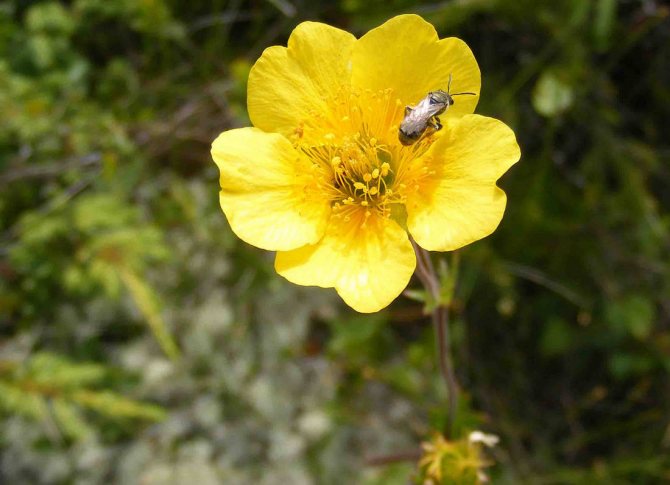

Creeping - has a significant similarity with the Gorny gravilat in terms of appearance. The "growth" of the perennial is also small - 15-20 cm. Inflorescences are golden yellow, solitary. The beginning of flowering is June. Inflorescences are similar in appearance to a bell, the head of which is directed upward or downward.
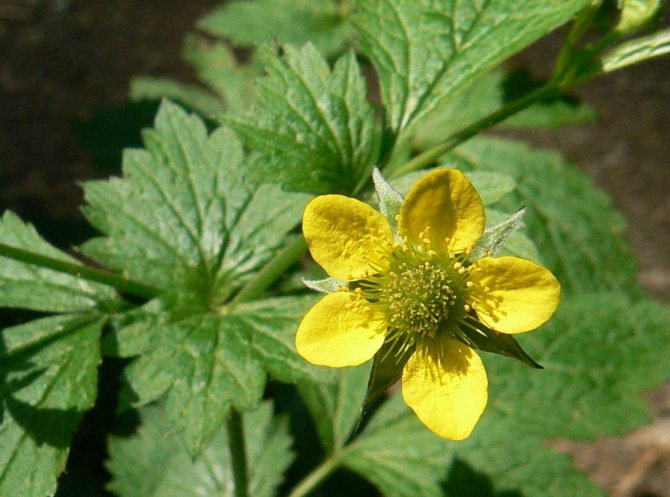

Urban - a fairly large perennial, the stems of this sort of gravilata reach a height of 40-60 cm. The beginning of the flowering period is May. In the case of planting in open ground, the plant does not require special attention to itself. Urban gravilat is also called bunchy or Benedictine herb.
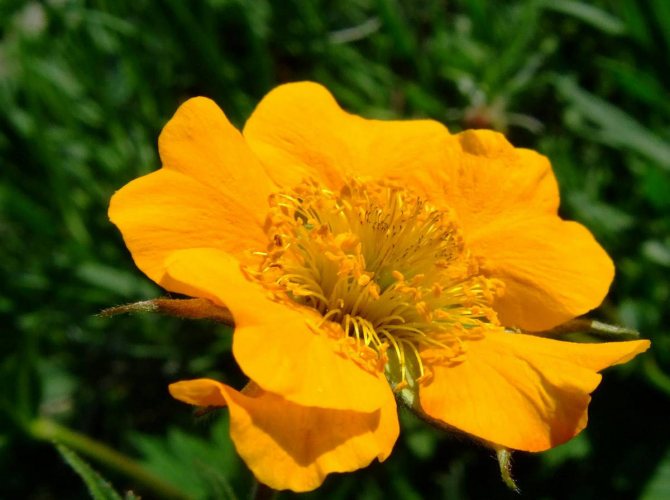

Chilean is a tall variety that is decorative. Perennial height - up to 60 cm. The flowering period is relatively short, up to 2 weeks. The buds open in late June, early July. The color of the inflorescences is deep scarlet or acid yellow.
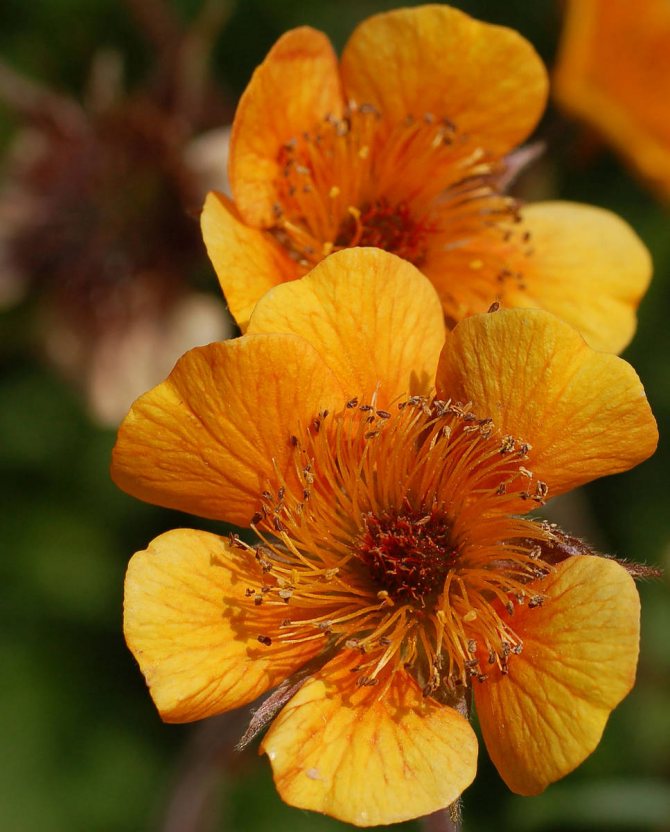

Hybrid is one of the most popular varieties among gardeners, which has collected all the positive qualities of wild-growing gravilates - Red and Chilean. The inflorescences are lush and double, the stems are powerful. Popular varieties of this species are Princess Juliana, which blooms in ocher yellow, Fire Opal, whose flowers are painted in scarlet orange, and Gladis Peri with scarlet inflorescences.


Tame, otherwise - River gravilat. It grows close to river beds and lakes, and is distributed virtually all over the world. It propagates only by seed. Perennial stems are erect, reaching 70 cm in height. Inflorescences are small and rather inconspicuous, painted in dark scarlet. In flower beds, this species is rarely grown by flower growers; the most popular varieties are yellow Lionel Cox and Album with white inflorescences.
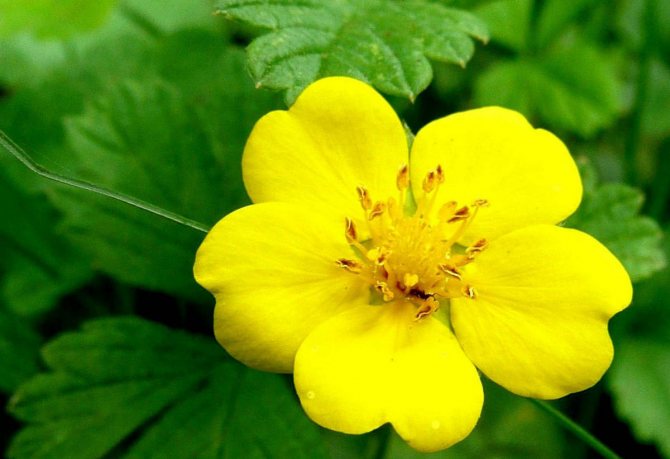

Rossa is home to North America. Natural conditions - arctic tundra. The perennial grows into a continuous carpet, the height of which is 30 cm. Inflorescences of a rich yellow color. The flowering period is summer. Winter hardiness is high, but prefers the soil without close groundwater.


Three-flowered - prefers swampy, damp areas. The height of the perennial is 30 cm. Decent winter hardiness, not picky in care. The inflorescences are painted either ocher-scarlet or violet-yellow.
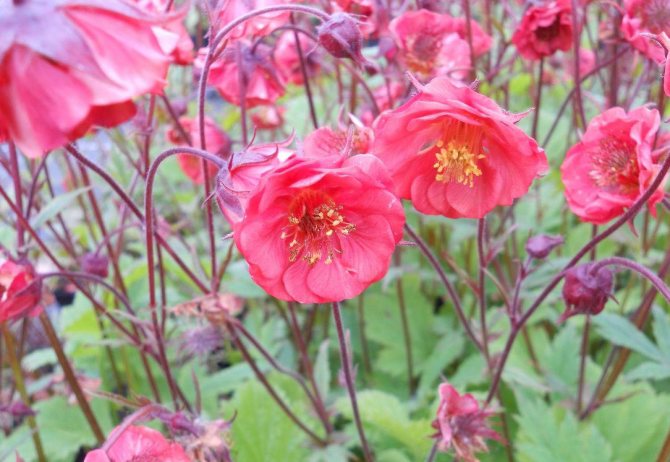

Red, otherwise - red-flowered gravilat. The stems of the plant are pubescent, the inflorescences are large, rich in scarlet color. The leaf plates are tripartite.Blooms from June to September. The most popular grade is Borizin.
For reference! Tall gravilata varieties can be cut for bouquets.
Landing features
To grow a gravilat on your site, you need to make a little effort. Planting a flower should be carried out after choosing the right place and preparing the soil. The plant is very fond of light, but is afraid of wind and drafts. Therefore, it is best to plant a flower near buildings or trees.
The soil for the flower should be loose and low acid, and also absorb water well.
First of all, you need to dig up the site for planting. After that, the fertile layer of earth must be mixed with sand and ash. This will help make the soil more permeable and less acidic. In order to provide the plant with additional nutrition, peat and humus can be added to the soil. After such preparation, you can start landing.
Use in landscape design
In landscape design, the flower is perfect for decorating compact alpine slides, thanks to its developed root system, it holds the soil and gives the composition a form.
When decorating rockeries, rabatok, in mixborders, the Red Dragon and Fireball varieties are used, which are distinguished by large bright inflorescences. These varieties are also suitable for cutting, they are used in the design of flower bouquets, panels and baskets.
In order to emphasize the beauty of natural or artificial reservoirs, a river gravity is suitable. It thrives on wet soil and retains its decorative appearance for a long time.
When decorating borders and flower beds, hybrid varieties are used. By picking up plants with different flowering periods, you can achieve a brightly designed composition from May to October.
Care features
Like any culture, Chilean gravilat needs care. Let's consider what is worth paying attention to.
Watering
Plant able to withstand slight drought, but this does not mean that you can not water it. In summer, when the air temperature is particularly high, it is necessary to water abundantly and regularly. Even if the flower has suffered from severe drought, it can be reanimated with abundant watering. In order to prevent root decay, it is worth building a drainage.
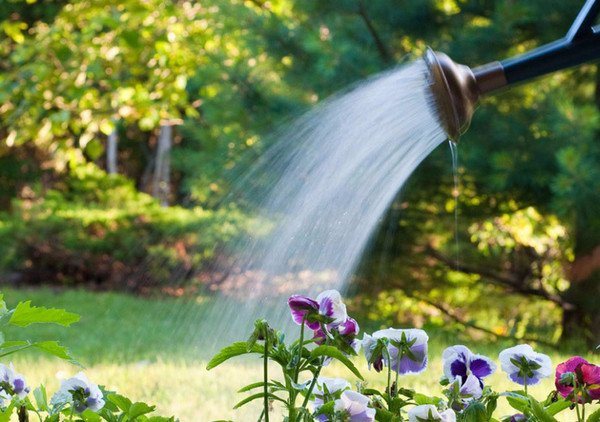

Fertilizer
Better to use for top dressing preparations based on mineral fertilizers... Please note that they must contain nitroammophos. This fertilizer is in the form of granules and contains nitrogen, phosphorus and potassium. Thanks to this feeding, performed 2 times a season, gravilat will delight you with lush and beautiful flowering.
Soil care
The soil in which the gravilat is planted must loosen up periodically, and also once a season add wood ash to it. If the flower grows on waterlogged soil, it is worth either replanting it, or raising it by adding soil.
Important! If after planting germination does not occur, you should not think that the seeds have died - they can sprout in a year or two. If you need a plant in the current season, it is better to plant its seedlings.
Sometimes there is a need for pruning. It may be needed to remove inflorescences that have faded, to rejuvenate the plant and give it shape. Pruning will have a beneficial effect on the gravillate and will encourage new shoot growth and brighter, more lush flowering.
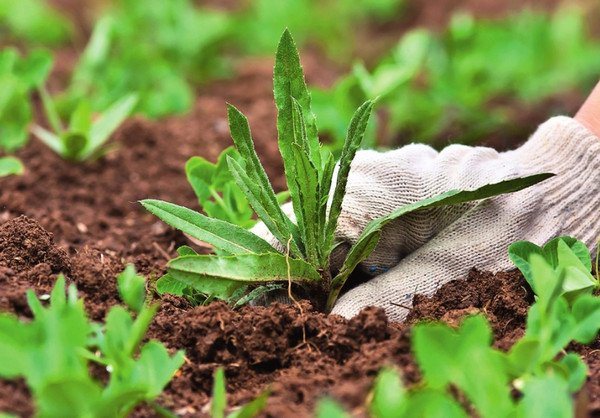

How to plant a Chilean gravilat?
Planting a plant should be done in the spring. Despite the fact that the flower does not belong to whimsical crops, it is recommended to loosen the soil a little beforehand... It is imperative to add peat or compost to it. If there is only soil with high acidity for planting, it is worth adding a little dolomite flour to it. When planting a crop, adhere to the recommended distance between bushes - at least 20 cm.
Did you know? If you add a tincture of orange peel and gravilat rhizomes to light low-alcohol drinks, they will acquire the taste of vermouth.
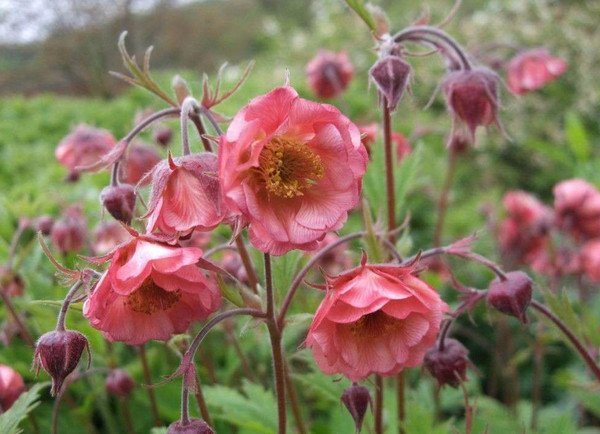

Planting a flower
we recommend using some tips:
- An excellent option when disembarking is the use of low, long ridges. They will harmoniously fit into the framing of the paths.
- Mixborders are another good solution. They are necessary for the collection of plants that bloom constantly. By planting a gravilat with other flowers, you can create a beautiful composition.
The flower can be used to create a carpet lawn. Due to the fact that such areas are more often in the shade, the bush will bloom less often, but it will delight you with beautiful greenery.
To decorate the borders, you can use: tenaciousness, dicenter, balsam, aster, bells, chrysanthemum, arabis, fuchsia.
Gravilat bright red


Gravilat is bright red, photo of the site Vitus and he is in the composition, photo of the site Vyatsky garden Gravilat is bright red (Geum coccineum, syn. G. x borisii of gardens) - bushy perennial from the Balkans; it can be seen in the upland meadows of the Caucasus, it is 30-50 cm high and 30 cm wide.The basal leaves are pinnate up to 20 cm long, the apical leaves are much larger than the lateral ones, from 5 to 15 cm long.The flowers are brick-red with golden stamens, up to 4 cm, collected in curls of 2-4; bloom from late spring to late summer.
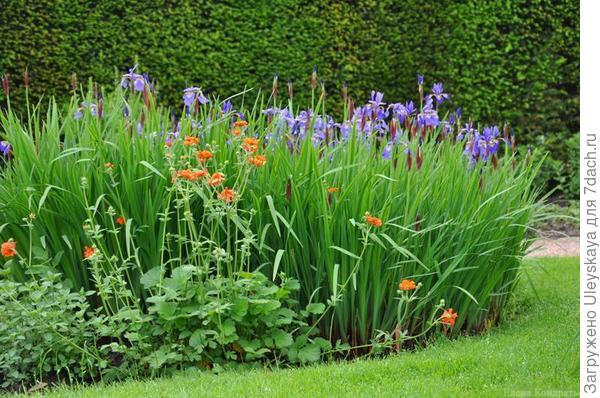

It is interesting in compositions with contrasting plants, for example, irises.
Description of the plant
Depending on the type of flower, the stem can be of different heights. In some species, the straight stem does not exceed seventeen centimeters in height. The flower has large, wrinkled green leaves. The flower itself is no more than four centimeters in diameter. The flowers are very beautiful with variegated hues, usually red, orange or yellow. Inflorescences are either paniculate or corymbose. They bloom for a long time, about two months, but some varieties bloom twice.
The root system of the flower is very well developed. Thanks to this, the plant perfectly tolerates any winter and blooms for a long time. In addition, the flower is completely unpretentious to care for.
The following gravilata varieties are especially popular with gardeners:
- mountain;
- creeping;
- Chilean gravilat;
- urban.
All these flowers look great in any flower bed due to their bright shades, especially gravilat Chilean is popular with flower lovers. But for the successful cultivation of perennial gravilate, you need to adhere to some rules for planting and care.
Basic rules for planting flowers
The decorative perennial is planted in open ground in the spring. For these purposes use seedlings that are grown from seeds.
Observing simple rules, you can grow beautiful flowers on the site:
- Sowing seeds to produce in boxes with nutrient substrate, to a depth of 2-2.5 cm, in March - April.
- Cover with glass or foil on top to create a greenhouse effect.
- The seeds will sprout in two weeks. The film needs to be removed.
- When three leaves appear, plant seedlings in the ground, not earlier than May.
- To choose sunny places or light partial shade... Avoid waterlogged areas.
- Maintain a distance when planting in the ground, as the plant needs room to grow.
With this growing method, flowering occurs in the second year.
The distance between the bushes should be at least 30 cm. Ideally, keep a distance of 40 × 40 cm.
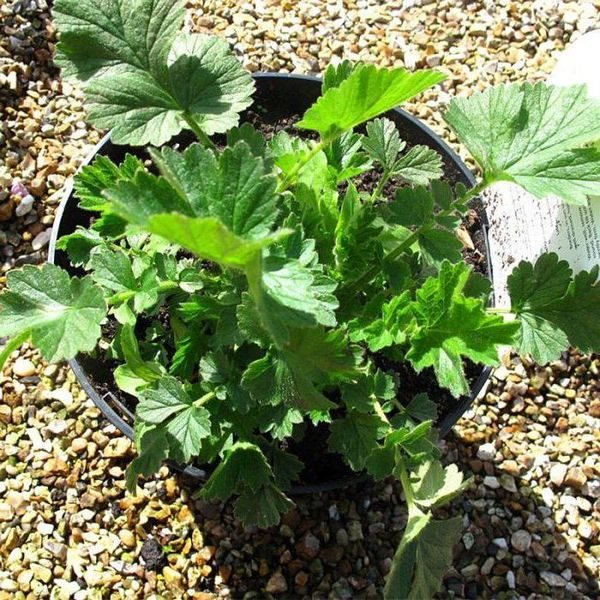

Grown seedlings before planting


Planting scheme of Chilean gravilat
You can plant seedlings that are obtained by dividing the bush... For this, plants that are at least two years old are dug up and carefully divided into parts.
With this method, flowers appear in the same year, at the end of summer.
When planting in open ground, it is worth taking into account:
- Drainage - a necessary condition for growing gravilat, since it does not tolerate stagnant moisture.
- The soil should be loose, moisture permeable well.
- A mixture of sand and soil will ensure the normal growth of the flower.
- Acidic soils unsuitable for this plant.
- Before planting, you need to fertilize the area. For this, the mineral complex N-P-K is suitable, organic fertilizer - humus or manure, well diluted with water.
- In each hole, before planting, put a little peat.
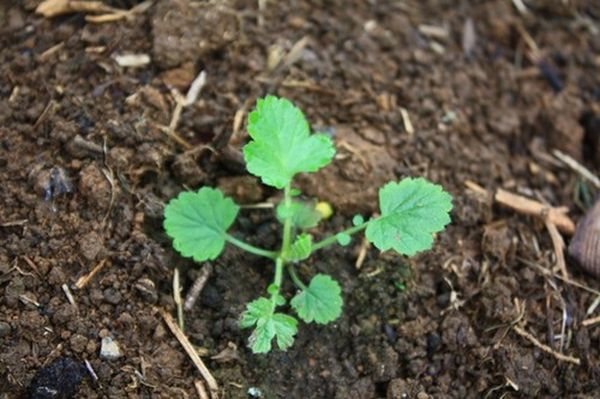

Delenka after planting in the ground
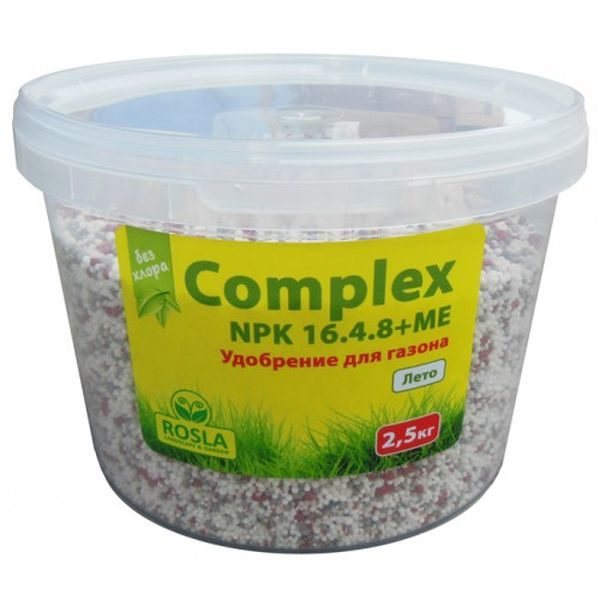

NPK fertilizer is necessary when planting by dividing the bush
Nursing and illness
Caring for a gravilat consists in choosing the right planting site and maintaining a low acidity of the soil. Regular watering is also important, but at the same time it is necessary to monitor the humidity and avoid excessive dampness at the planting site.
| Basic care guidelines | |
| The soil | The soil is regularly loosened and weeded, sawdust, sand or pebbles are used as mulch. Mulching increases the air permeability of the soil, protects against weeds and improves the appearance of the flower bed. |
| Watering | During the drought season, watering is needed, otherwise older sockets may die off in favor of young ones. |
| Top dressing | Spring feeding with a complex mineral fertilizer or herbal infusion is enough. |
| Pruning | In early spring, pruning of old leaves is required, and after flowering, peduncles. In autumn, it is recommended to prune old leaves and peduncles, cutting off the ground part of the plant. |
| Wintering | When growing a perennial in harsh climatic conditions for the winter, you should cover it from frost with mulch, spruce branches or a special film. More often, terry gravilata varieties, as well as those planted in autumn, need a similar procedure. When the plants grow, they themselves will cover the root system with leaves. |
| Diseases and pests | The perennial is resistant to disease and is practically not afraid of pests. The exception is fungal diseases. You can get rid of the fungus from the plant by treating it with a fungicide. |
Plant propagation
The easiest way to reproduce is to divide the bush. The plant is dug out of the ground, the rhizome is shaken off from the soil and part of the plant is separated with a garden knife. The operation must be done so that each delenka has not only a part of the rhizome, but also the ground elements of the plant.
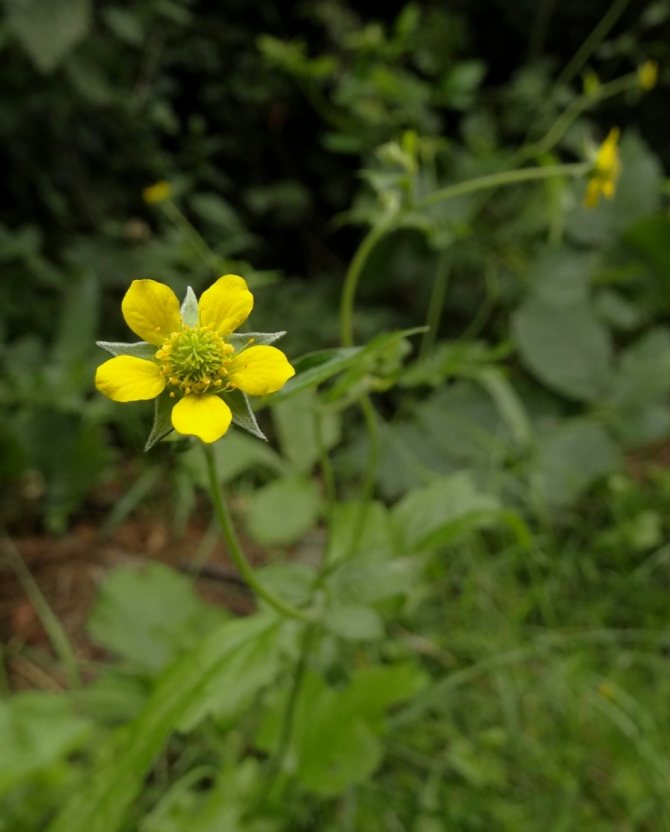

Places of cut at the mother plant and delenki are sprinkled with charcoal. Activated carbon is also used for this purpose. The resulting plants are planted in prepared pits. You can divide the plant in early spring or autumn.
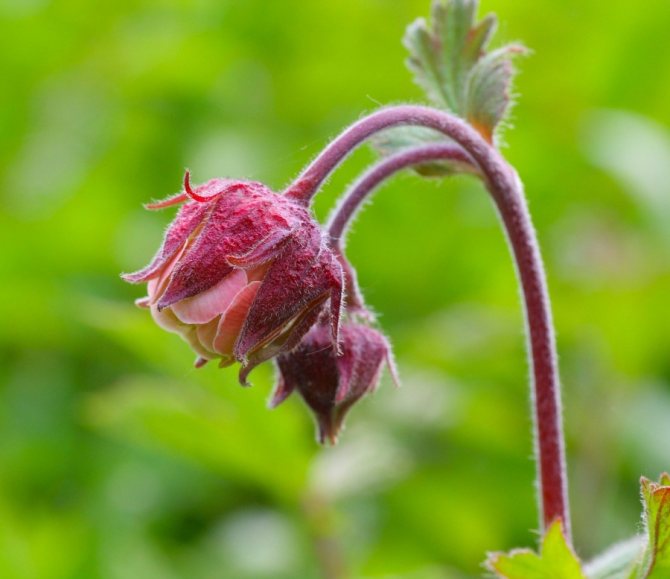

In the latter case, it is recommended to do the manipulation before the onset of cold weather (mid-October), so that the plant has time to take root. Therefore, autumn breeding is recommended to be carried out in warm climatic zones.
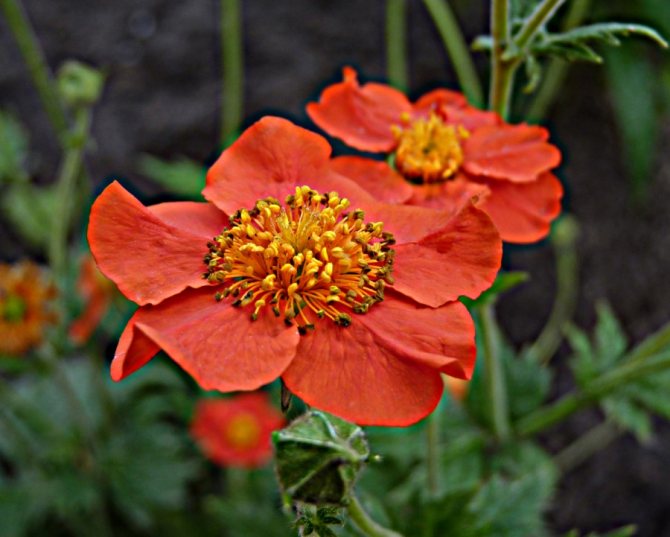

Planting gravilat with seeds is more laborious. First, in early March, you need to plant the seeds in boxes with soil mixture, including sand and peat. The planting box is covered with glass after sowing. It will need to be removed only when the first shoots appear.
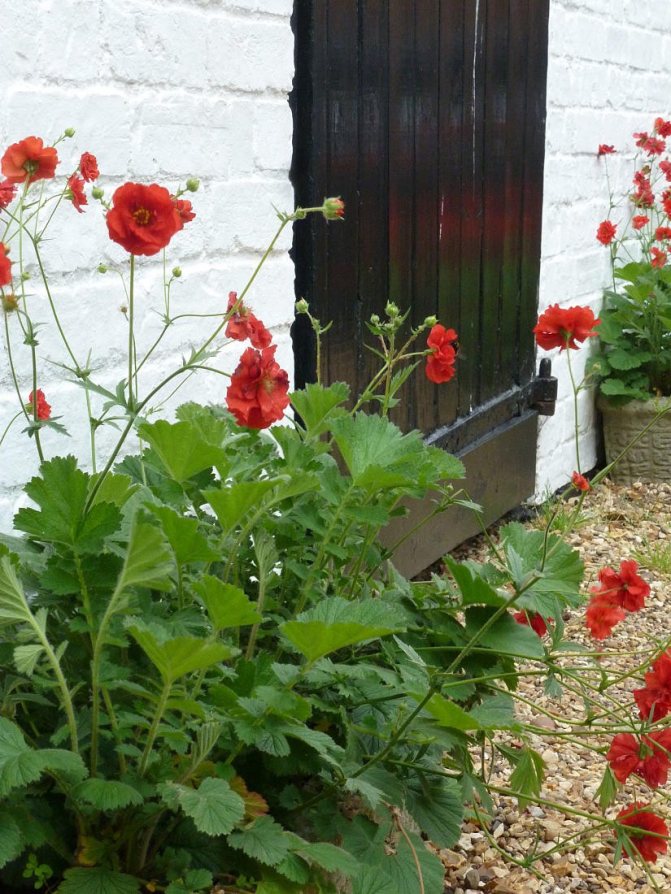

The sprouts germinate in greenhouse conditions until the first true leaves appear. At the end of April, the seedlings are transferred to open ground.
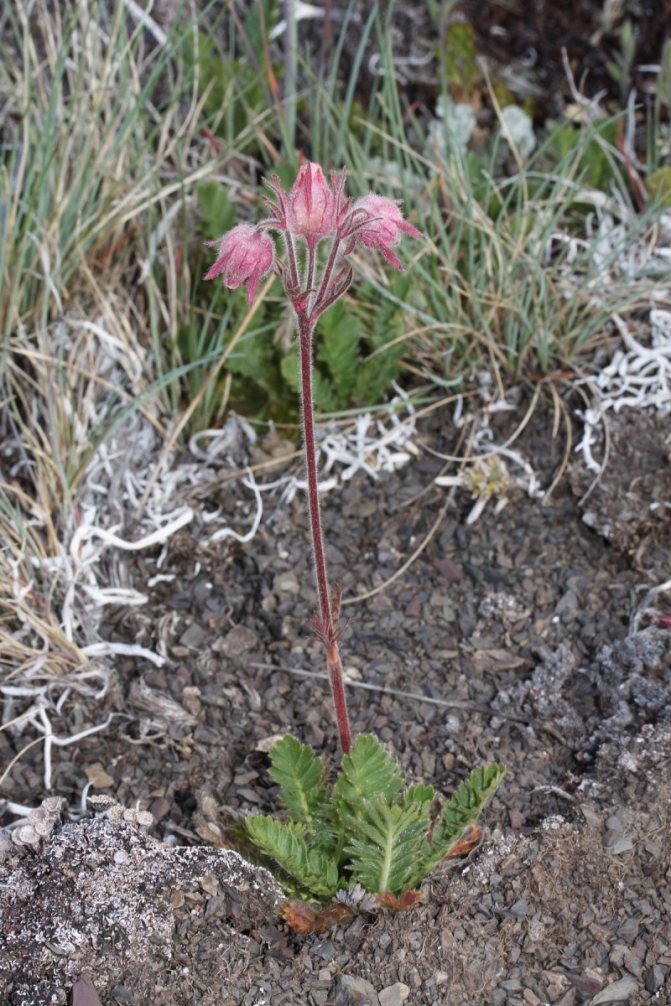

Since return frosts are possible, it is recommended to think about covering with agrofibre or film. It is possible to expect the appearance of flowers with this method of reproduction only in the second year.


Gravilat Aleppo
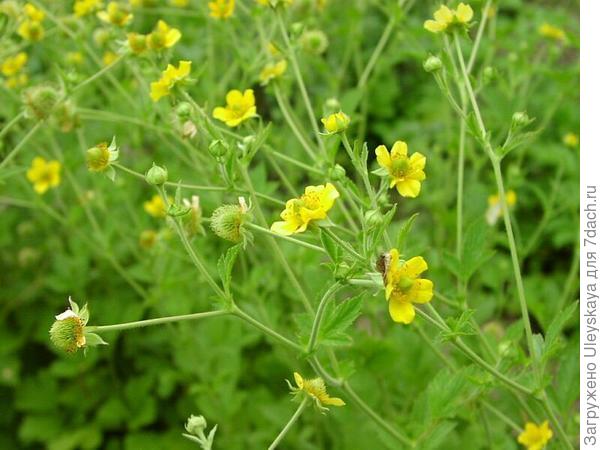

Gravilat Aleppsky, photo of the site vasily_sergeev - LiveJournal Gravilat Aleppsky (Geum aleppicum) is a short-rhizome perennial up to 70 cm high; it is very similar to the city city, but in contrast to it it is larger and its peduncle is shaggy. It grows in forest and steppe meadows, in birch and larch forests of the European part of Russia, Siberia, the Far East, Central Asia, North America. Our Vera from Biysk should know it, because it is distributed throughout Altai. It has beautiful bright green rosette leaves.The flowers are yellow; bloom in late June - July. It gives abundant self-seeding, displacing other types of grasses, therefore, it is necessary to control its growth by timely removal of faded peduncles.
General description with photo
Gravilat is a rhizomatous perennial plant with straight stems, assigned to the Rosaceae family. Stem foliage is large, has a pinnate-lobed shape and forms a dense basal rosette. Near the ground, short-peaked leaf plates are almost lyre-shaped. In culture, the flower is often called avens. The creeping woody root goes deep into the ground and gives rise to numerous root shoots. Creeping stems on fertile soils can reach considerable length, taking on a paniculate appearance at the very top.
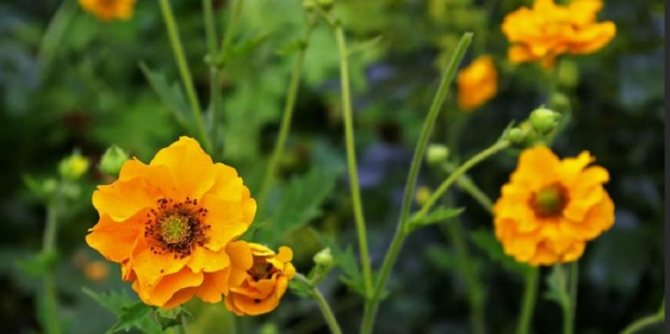

By the middle of summer, rigid peduncles with buds of red, light yellow or bright orange color are taken out of the root rosette. They can be either single or collected in paniculate few-flowered inflorescences. During flowering, gravilat looks light, lush and airy. By autumn, in place of the inflorescences, oval seeds, hooked at the end, are formed. The hooked hook at the end allows the seeds to easily cling to the fur of the animals, allowing them to be transported over long distances.
Some varieties are successfully used as ground covers.


